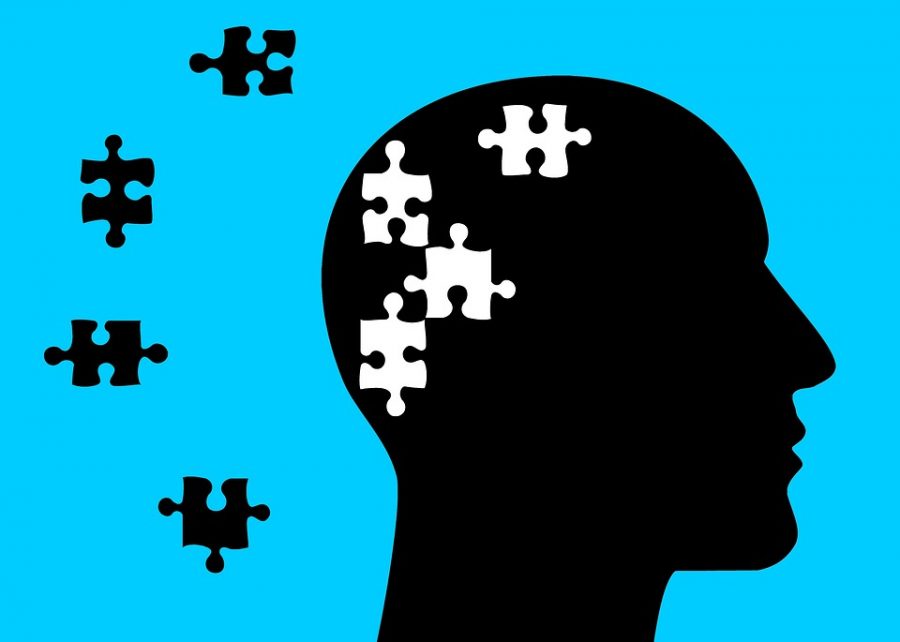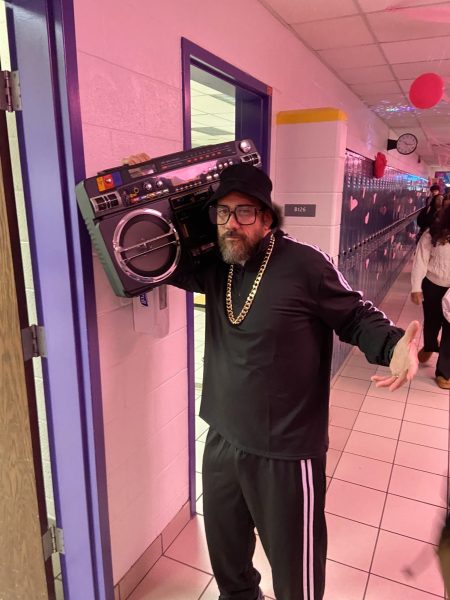Are schools equipped to tackle student mental health?
May 21, 2018
The National Institute of Mental Health states that approximately one in five adolescents has or will have a severe mental illness. In a survey of Tallwood students, 79% claimed they knew someone at school who had been diagnosed with a mental illness or experienced regular, significant mental health issues. Considering adolescents spend seven hours a day, five days a week in school, and the majority of their social lives and energy are spent within the walls of their school, it only seems to make sense that the school would have adequate resources available to aid students in making sense of some of the most transformative and confusing years of their lives. To what extent does Tallwood actually reflect this, however?
Students were given the chance to anonymously voice their opinions on the topic of mental health in an online survey conducted by The Roaring Gazette. The answers students gave in regards to the topic of how their school handles mental health were diverse in nearly every respect, and this is not entirely surprising, for not every student experiences significant mental health problems, and those that do experience it extremely differently, even among those who might have the same disorder. In this survey, 65% of surveyed Tallwood students claimed that they did not feel that their school adequately provided for the mental health needs of students.
It is important, however, to not bash the school system, the teachers, or the counselors for the lack of adequate resources for students with mental illnesses, for these individuals truly care about students and work hard to improve mental health despite their limitations. There are a variety of reasons for the lack of adequate resources to handle student mental health, one of the largest being the argument that it is simply not the school’s job.
“I do not think that it is the role of the school to address student mental health. I believe that a licensed mental health provider should address mental health. There is very specialized training and education that individuals go through to provide care for people with mental health struggles and few, if any, school professionals are trained and licensed to deal with mental health,” comments Ms. Huff, Tallwood psychology teacher.
In addition to this, it is likely that a number of other factors converge to create this lack of training and resources in public schools to handle student mental health. An already-thin budget, an already-overworked staff, and a fear of upset parents and lawsuits all come together to form the situation we see now.
As mentioned, most school professionals are not trained to deal with student mental health issues, including teachers. Most teachers will not receive training on what to do if a student has a panic attack in class, what to do if a student won’t touch their assignments in class due to a severe lack of energy and motivation, what to do if a student says they are suicidal. Tallwood English teacher Mr. DeMott gave his response on how much training teachers receive in regards to student mental health.
“In all reality, close to none….You could say that every year we teach is kind of like a training for student mental health, so experience becomes our teacher,” says DeMott.
While at least some level of self-teaching through experience and individual research is obviously necessary in a teacher’s development, it is not necessarily enough to meet the needs of students. If a teacher is lucky enough to be able to even recognize the symptoms of mental health struggles in a student, it is typical for them to just send them off to guidance in hopes of the problem being fixed there.
“One of the things we do is get students to the right place….Whether or not something is adequately handled is maybe something quite different, but I think the equipment is there….In one way, I want to know that I can pass a student on to somebody who is more of a professional in this realm of things and hopefully the student gets their needs met. On the other hand that doesn’t necessarily improve my ability to work with them. So, me sending them away and having them come back ‘fixed’–and that’s kind of a sarcastic way of putting it–that doesn’t make me a better person to be one of the tools to fix it,” comments DeMott.
“[If I was worried about a student’s mental health,] I would speak to the student’s guidance counselor or to my administrator,” confirms Huff.
The School Counseling office may be the best place to send a student struggling with mental health, but it is important to understand the roles, and limits, of School Counselors. Guidance counselors cannot legally practice any clinical-type therapy or intervention in the aid of students. The Virginia State Government states that each school board shall contain “a provision prohibiting the use of counseling techniques which are beyond the scope of the professional certification or training of counselors, including hypnosis, or other psychotherapeutic techniques that are normally employed in medical or clinical settings and focus on mental illness or psychopathology” (Legislative Information System).
However, Senate Bill 1117 passed in July of 2017, which requires “every person seeking initial licensure or renewal of a license with an endorsement as a school counselor to complete training in the recognition of mental health disorder and behavioral distress, including depression, trauma, violence, youth suicide, and substance abuse” (2017 Session). Though the new requisite for counselors to receive a license in recognizing mental disorders is a positive step forward, they are only getting training on recognizing symptoms and are still unable to provide any sort of treatment or help. Many students have complained that their school counselors are not doing their job as “counselors,” but there is a failure among students to understand the professional role of guidance counselors.
Click here to see an interview with the School Counseling office about student mental health and the role of counselors.
On top of this, counselors often have hundreds of students they have to keep track of as well as an assortment of other responsibilities that are placed on their shoulders, and the fact is that it is just too much to be responsible for. Recognizing this particular issue, some students had some ideas on how to improve.
“I think there should be a few people in the school administration who are always readily available and whose sole purpose is to help students with mental health issues,” comments one Tallwood student.
Aside from the school guidance counselors, Tallwood does have a few staff members who are supposed to assist with student mental health. One of these people is the school psychologist. According to the Virginia Department of Education, school psychologists “provide a variety of professional services to support the academic achievement, positive behavior, and social-emotional wellness of all students, especially those who struggle with barriers to learning” (School Psychology Services). As stated by the Virginia Department of Education, school psychologists primarily work with students who struggle with barriers to learning, and are not necessarily dealing with the overall mental health of the general student population, as the title might suggest.
The other staff member that supports student mental health is the Student Support Counselor. At Tallwood, the Student Support Counselor is Mr. Nicholson, who shares an office space with Ms. Gastler in the guidance department on Mondays and Wednesdays.
“Ultimately, I’m a resource in guidance who assists with the holistic development of students (grades, attendance, behavior, and post-secondary plans). Although I like to be a service to all students in Tallwood, I primarily assist students who are transitioning from alternative education settings to their home school, or students who are deemed as at-risk. I support students to assist them with achieving SUCCESS,” says Nicholson.
Mr. Nicholson splits his week between Tallwood and Salem High School. Though he tries to be as available as possible to all students, two days a week is not as readily available as students might need him to be. In addition to this, he, like the school psychologist, primarily deals with specific students and isn’t necessarily in place to support the entire student population. This isn’t to undermine all the hard and important work that both individuals do to serve students; it is simply that the realities of their jobs perhaps do not serve the general student population’s needs as well as students might hope. Despite this, Mr. Nicholson works to ensure that the students he does collaborate with have a space in which they can feel truly comfortable.
“I like to describe my office as a ‘safe space’ for students. A place where they have a trusted adult to speak with about their needs or concerns,” says Nicholson.
Ideally, this “safe space” would extend throughout the school, throughout classrooms, and throughout individuals. Because teachers are the school staff that students typically interact with the most, this safe space should begin in classrooms.
“My role is to create a safe environment in the classroom where every student has the opportunity to learn, free from unnecessary anxiety or fear,” states Huff.
Unfortunately, because teachers already wear so many hats and dedicate so much time to their students, it can be difficult to add additional responsibilities regarding students’ mental health. Watching out for and handling signs of mental health problems are often argued to be a teacher’s responsibility, but this gets tricky, considering teachers often have over a hundred students. Additionally, it can be hard for a teacher to differentiate between a true mental health problem and a temporary low mood, someone’s personality, or a myriad of other factors that could contribute to a student acting in a certain way. However, teachers see their students almost every day, and they truly are sometimes the best observers that a student has for noticing any problems, even with the tracking that is done with students who are deemed “at-risk.”
“I know there’re ways to track students, and I’m sure all that stuff is done, but in reality the person that you’re in contact the most with as a student is the teacher you spend ninety minutes with every other day,” says DeMott.
A relationship between a teacher and a student is sometimes the only way for a teacher to become aware of any issues a student might be going through.
“I think if students could develop a connection with teachers at the school that makes them feel like they could talk to them,” comments one Tallwood student.
A student may not always feel comfortable talking about their struggles, so it is often up to the teacher to reach out to the student and make it known that they are there to listen and they genuinely care. Additionally, misbehavior or apathy from a student, though often frustrating to a teacher, can be understood and often improved when a teacher exercises empathy and works to build a relationship with the student.
Teachers also commented about the importance of relationships between students and teachers, emphasizing the need for a teacher to know their students mental health needs in order to properly empathize and accomodate for that.
“Teachers teach the student, they don’t teach the content…so the teacher needs to get to know the student well enough to know their needs….[My role as a teacher] is to know my students, and know their needs,” says DeMott.
Mental Health First Aid recommends using the question “how can I be helpful?” when dealing with a student who is suffering. A teacher cannot always do anything to help, but it can aid in the prevention of allowing a student to isolate themselves, and it constructs a bridge of empathy that is often critical in helping a student manage their mental health (“Even Teachers …”). Even if a teacher can’t solve issues going on in a student’s life, the student can provide solutions to, at the very least, help alleviate their stress so that more baggage does not pile on.
Aside from the lack of knowledge and training, there might be a problem with the structure of schools. Ms. Huff gave her opinion on a large issue regarding the schedule of schools.
“The best thing we could do for ALL of our high school students is to follow the AAP guidelines for high school start times….There is HUGE connection between sleep deprivation and mental health. Studies suggest it leads to or plays a role in depression, anxiety, suicide, mood volatility, angry outbursts, ADHD, and a host of other disorders. Studies also suggest that when you are sleep deprived you form twice as many memories of negative events in your life verse positive events….And of course, sleep deprivation affects learning, memory, the immune system, the endocrine system, the list goes on, but the point being that any of this can affect school performance which in turn can affect mental health,” says Huff.
Sleep deprivation is a problem that afflicts many high schoolers, and there are mountains of research that have come out in favor of pushing high school start times to later to match the natural circadian rhythm of teenagers. If a high schooler lives their life out of sync with their biological clock, it makes them extremely susceptible to all sorts of mental and physical troubles. If school is the root of many mental health problems, then it only seems natural for schools to take responsibility and make a change.
Students also had some other ideas about how they felt they could be better accommodated.
“Bring more awareness to other students that might not have a mental illness, so they can help out if they come across someone that does have one, or if they develop one overtime,” suggests one student.
49% of surveyed Tallwood students claimed they did not feel like they knew how to tell or how to help if they or someone else was experiencing mental health problems. If the school cannot do enough to actually handle students’ mental health problems, it is safe to say that the least they could do is provide the students with more knowledge and resources to help them cope themselves or to get help from someone outside of the school.
Although there is some existing content in the Virginia health curriculum that deals with mental health, it is not truly adequate in meeting students’ needs. Some of the curriculum’s standards include: “Identify signs, symptoms, and sources of stress and anxiety….Identify signs and symptoms of depression, risk factors for suicide, and risk factors for other self-destructive behaviors…Identify appropriate coping and resiliency strategies to manage symptoms of stress, anxiety, loss, and depression….Discuss the causes, symptoms, harmful effects, and treatment of eating disorders….Determine how to help a friend exhibiting signs of depression, anxiety, disordered eating, or other self-harming behavior” (Health Education Standards of Learning for Virginia Public Schools).
While a general foundation of knowledge on topics such as depression, anxiety, and eating disorders as well as a straightforward list of facts on coping with stress or an upset friend may hold a degree of beneficiality for students who were previously uneducated on such matters, it only scratches the surface of many students’ needs, as it lacks a personal touch. Each individual has completely different experiences, and there isn’t much argument combatting the assertion that everyone needs advice and support tailored personally to them so that they can better deal in responding to what life throws at them.
“…life can be overwhelming at times, and students do not always know how to respond,” comments Nicholson.
Mr. DeMott shared what he believes should be the first step in responding to life’s difficulties, specifically mental health issues.
“I think if there’s an awareness and there’s a belief that it’s just a biological thing that happens, and there’s a normalcy to it, it’s a much better step one for a student to have as opposed to wading through all the garbage of seeing if you’re normal or not….I’m not even talking about just the teaching profession, there is a societal problem with that….” says DeMott.
There continues to be a great deal of stigma surrounding the topic of mental health, and this subsequently plants clouds of doubt in many teenagers’ minds about themselves and their relationship to their mental health.
“Our culture unfortunately shames and ridicules mental illnesses, which might deter someone from talking about them,” comments one student.
Despite this continuing stigmatization and awkwardness that revolves around mental health, it is encouraged for individuals to open up and speak their mind, in combat with all the doubts and insecurities pounding around in their minds. This requires work from all ends, but Mr. Nicholson asserts that it is ultimately up to the students to exercise empathy and courage with each other to create a peer community that is open and understanding.
“To improve student mental health, I think there should be open-dialogue/peer group discussions led by the student leaders. I believe that will allow students to see that they are not alone when dealing with mental health. It will also bridge the gap within the student body creating more connectivity. I think the biggest thing is making students understand that they are not ALONE,” says Nicholson.
More than anything, in a sea of legal stresses and budget constraints, teachers, administrators, and students need to be taught to empathize and connect with one another because, at the end of the day, it is the responsibility of each and every individual to care for one another and ensure that they can leave someone feeling a little less alone while allowing them to be able to wear their pain on their wrists without the fear of being judged.
Citations
“Even Teachers Need to Be Taught.” Mental Health First Aid, 24 June 2016, www.mentalhealthfirstaid.org/success-stories/even-teachers-need-taught/.
“Health Education Standards of Learning for Virginia Public Schools.” Virginia Department of Education, Virginia Department of Education, 2015, www.doe.virginia.gov/testing/sol/standards_docs/health/2015/stds_2015_health.pdf#page=23.
Legislative Information System, leg1.state.va.us/cgi-bin/legp504.exe?000%2Breg%2B8VAC20-620-10.
“Let-Them-Sleep-AAP-Recommends-Delaying-Start-Times-of-Middle-and-High-Schools-to-Combat-Teen-Sleep-Deprivation.” Site Title, www.aap.org/en-us/about-the-aap/aap-press-room/Pages/Let-Them-Sleep-AAP-Recommends-
Virginia Department of Education. “School Psychology Services.” VDOE :: School Psychology Services, www.doe.virginia.gov/support/school-psychology-services/index.shtml.
“Standards for School Counseling Programs in Virginia Public Schools.” Virginia Department of Education, Virginia Department of Education, www.doe.virginia.gov/support/school_counseling/counselingstandards.
“2017 Session.” Virginia’s Legislative Information System, lis.virginia.gov/cgi-bin/legp604.exe?171+sum+SB1117.






















Scott Morelli • May 24, 2018 at 11:20 am
Mental health is a huge deal in our society, especially in the teen population. We have been taught that “staying in line” is the best thing for us and if we were to step away from that, we would be shunned. Admitting that you have a mental illness is not easy, especially to those who know you best. In school, whenever mental health is mentioned, almost everyone goes on high alert. This is why it is not only the teacher’s job, but the students as well to allow these “flaws” in our “cookie-cutter” lives to be brought awareness and support.